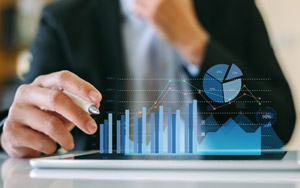 by Shannon Flynn
by Shannon Flynn
The COVID-19 pandemic has been one of the biggest influences on retail in recent history. It has changed the way consumers shop and interact with companies, which means retailers are stepping up their game to meet these rapid changes. Data analytics is a modern solution to the recent setbacks in the retail world. For small businesses, this will enable countless steps forward, from better business decisions to robots in retail.
Business Decision Optimization
Small business owners must make the most profitable decisions to succeed in their industry. Just as larger corporations use data analytics to make decisions, indie retailers can do the same, but with smaller pools of data. Therefore, it is important to first understand where to gather decision-making data.
A small business owner should use multiple forms of data to improve and optimize operations. Foot traffic, point of sale (POS) systems, website traffic, social media engagement, pricing, competitor behavior, and consumer trends all produce a form of data that retailers can take into account for informed decisions. For instance, if the data shows competitors have better deals or prices that are working for them, the retailer may need to shift their own prices. They could offer a better deal or discount that draws consumers into the store or to their ecommerce site. It is critical to cover both bases.
As data analytics systems consider this information, they can make predictions for the future that retailers can act on. If the system shows an upcoming trend of interest in a specific fabric, home decor stores can advertise that material or pattern at the front of the store or online. Tactics such as this can help draw in more customers and profits.
Supply Chain Management
When the pandemic first began, supply chains were under immense pressure as workers needed to push through being understaffed while maintaining safety protocols. As supply chains continue to recover and adapt, retailers are in the same position as they rely on supply chains to deliver their products.
Data analytics will again be invaluable. Using the same predictive analytics retailers do for business decisions, they can see what products or services will receive high demand for the coming weeks or months. Then, businesses can order the corresponding inventory and supplies ahead of time to meet that demand. In addition, retailers should compare the data they have from each supplier and manufacturer they work with. If one lacks efficiency or fails to meet deadlines, the retailer can switch to another service, which will save them money as they do not have to make up for lost profits or expenses.
It is important to keep security in mind during these partnerships and interactions. Due to pandemic-driven reliance on technology, cybersecurity threats have risen in the past year. It is critical for indie businesses to invest in cybersecurity systems to protect their data and their customers’ data at all times, both online and in stores, and along the supply chain.
Customer Shopping Experience
When it comes to the bottom line, providing the best customer experience will have a significant impact. Here, retailers have room for innovation and progress through data analytics as they expand what is possible for shopping. Automated alert systems can help the customer experience by notifying brands when an item is out of stock. This step will help keep top-selling items on the shelves. Automated systems can also show what products interest consumers, which retailers can then advertise to facilitate a better experience.
Augmented Reality (AR) is another way to use data analytics for customer satisfaction. For instance, IKEA has been using an AR app where consumers can place items in their home virtually using their phone and then change the size and color. This way, shoppers can see precisely what they want to purchase, which reduces return rates and improves satisfaction. Then, more retailers can use that purchase data to know what to order and advertise that item or service more often.
Finally, robots in retail perhaps have the biggest potential to take off as a major customer service benefit. These robots, like Pepper or Millie, can help small businesses draw new customers in, providing a new way to shop, while also assisting shoppers in finding different items throughout the store. With the data collected by robots based on purchases and engagement, brands can act with confidence as they make decisions for their customers.
Retail Always Evolves
Just as retail has done throughout the pandemic, it will continue to evolve with data analytics this year and in the coming years. These technologies enable businesses to make evidence-based decisions, properly manage their supply chains, and provide consumers with the best experience possible. Data is the key to each step for small businesses in any industry.